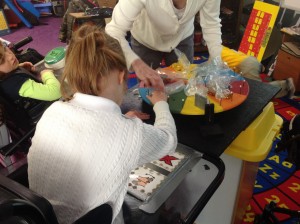The process of creating my unit was very labor intensive but as I look back, I am very excited about everything I learned and the potential of sharing my creations throughout the state.
Just this past week, I was able to visit some teachers, therapists, and parents in Washington County, NC. As a member of a statewide Deaf/Blind Teacher Support Program, I was visiting their classrooms to provide technical support in how to teach students with severe disabilities and deaf/blindness. It was an eye-opening experience to see how some areas of our state have so few resources. I wish I had the financial means to get them what they needed for their students. The staff in that county are to be commended for how well they do with the limited resources they have.
One thing I can do to help them is to share my lesson plans, teaching ideas, and videos from my Kenan Fellows Unit. Sometimes you can see things on paper and they don’t have much of an effect but sharing the videos of the lesson implementation really makes a difference. The unit plans give examples of how they can incorporate individual communication, literacy, and math goals into the science unit. My Kenan lessons will give them a basis from which to begin to write science lessons for their students.
I am in the planning stages now for presenting my Kenan plans at an NCDPI Summer Institute this summer for teachers of students with severe disabilities and deaf/blindness. I am also working on presenting information at the NC DPI Exceptional Children’s Conference in the fall. My work with the Kenan Fellows Program will be a large part of the information that I will share. I am very thankful for the opportunities that my Kenan Fellowship has provided
There are not many resources out there for teaching science to students with severe disabilities. I am excited to be a part of helping that area to grow!

